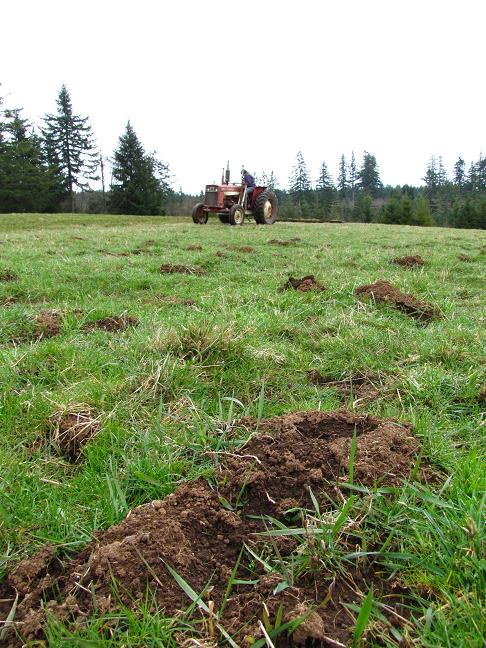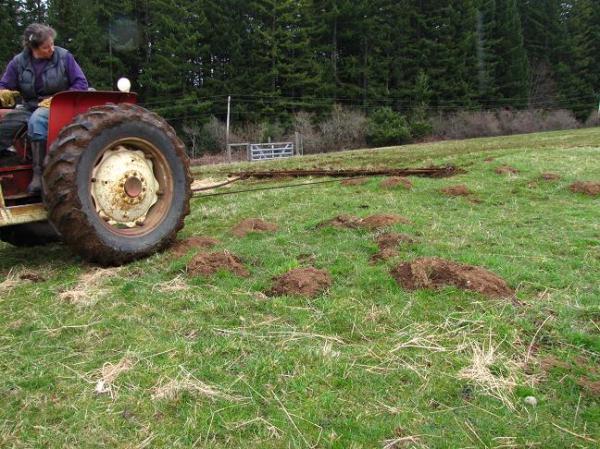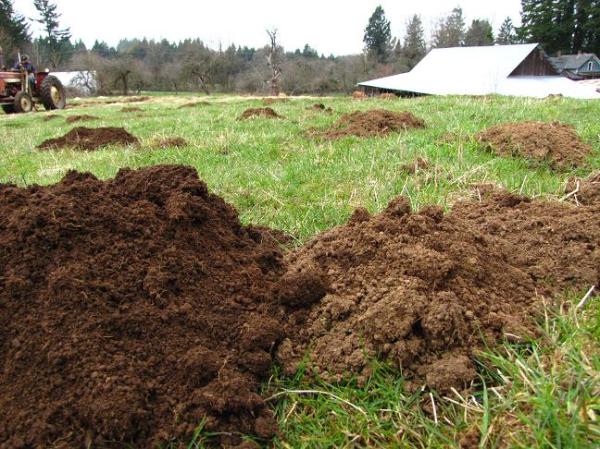The Other “Worm Casting”
There is an old saying, “grease is cheaper than parts.” I’m going to add mine to that, and say that leveling out molehills is easier with a drag or harrow than with a haybine. Kind of a stitch in time, saves nine sort of adage. There is no method of farming alive that doesn’t keep some of the old ways, and blend them with the new ideas, or the latest way of thinking. Currently, the rage is ruminants can save the world, thanks to the internet making folks like Allan Savory available by video to the general public. I happen to agree that grazing ruminants (in my case cattle) makes the land better. But there is no redemption or repair without disturbance, and depending on how you view disturbance it may be by high density, short duration bursts of grazing which we do, or it may be by iron plow if you’re into market gardening. Here it is a blend of old and new methods, one size fits all just doesn’t work once you get step away from the worksheet. As much as I would like to, there is no getting out of making hay on our farm. I prefer not to buy hay, so we raise our own. I see making hay as a way to vary our stocking rate without selling cattle off to match the grass growth. We do vary our stocking rate by harvesting our meat animals during the early summer when the grass is at it’s best, and the meat the most nutritious. But, I’m not in the cattle selling and buying business, I’m in the “make my farm land better” business. It would be easy to not get attached to my cattle and just buy and sell as the grass waxes and wanes, and save myself a lot of work, but I’ll leave that to other folks. So to that end, we have to manage our pastures and hay ground for what they are. We do mix it up a bit, but for the most part, our flattest (read easiest to make hay on) fields always end up getting some hay cut each year. It varies from year to year, but basically we drop certain paddocks out of the grazing rotation and make hay on them.

As long as I can remember, dragging the fields during spring vacation has been my job. Part of that came from me being out of school for a week, and that’s a job a kid can do, and the other part is that timed out about right for winter feeding being about over, and manure and molehills needing spread out before grass growth began in earnest. Two things to remember: 1) I’m old enough that spring vacation meant a week out of school, not taking a vacation somewhere exotic. 2) We fed our cows outside in the pasture and there was some accumulation of spoiled hay and manure, not to mention rough ground that could use some leveling off.

Well, sure enough it is spring vacation, and where am I?’ On the tractor dragging molehills. I don’t remember getting such a crick in my neck though when I was a kid. Mebbe my neck is a little old?

Since our pastures are not lawns, and we are looking for diversity, we see the molehills as a boon and boost for fertility. The moles are a sign that we have a lot of worms present, and the moles are doing their thing. In the process of finding worms and grubs to eat, they are mining out and bringing to the surface some might mineral rich dirt. Killing moles is about like killing slugs, you either have to live with them or die trying to eradicate them. I’ve seen folks pretty successful with 16-16-16 fertilizer, burns the worms, sets back the clover, and makes the moles clear out due to lack of food. But I would rather have the moles than the monocrop pasture or the fertilizer bill.
I no longer drag all the fields, and we feed inside mostly during the winters these days, so on the fields marked for hay, I’ll drag down the molehills so they don’t get sodded over and make a rough field. In the pastures that will only be grazed, I don’t worry about the molehills, the cows have been more than happy to use them to rub on, and if they don’t rub them level, they surely tromp them flat in the mob stocked paddocks throughout the summer.

I still think pasture harrowing has its place in certain applications. Well timed just before a rain, harrowing is a great pasture management tool to have in your toolkit.



No moles here yet but I am working on it! My fields have a few years to go until they are fertile enough to have good worms, and microorganisms. Industrial horticulture will do that to soil! Yours looks great though. I look forward to seeing your summer! have a lovely day… c
C, things are waking up here! Sorry to gloat about our warm side of the high pressure, but while harrowing I saw a hummingbird, a buzzard and 3 violet green swallows – it truly is spring now!
green swallows, i bet they were darting and diving around you as you worked.. and gloat away honey, I am catching up!! slowly.. (laughter).. c
Would you mind sharing a bit more about that homemade harrow? We have some mongo molehills in our flattest pasture. Thanks for sharing your experience. I didn’t realize the buggers eat worms (I thought it was just grubs). I figured on killing them all after letting them mix in some compost for me. 😉
harrietnw, it’s a doozy that my brother made, made from a length of railroad iron with pieces of track chain (from a Cat) welded on for the dispersing part. You know how farmers are, they never throw stuff away that may have some other use or be fabricated into something else. I love it!
Sounds like a doozy! Nice! I keep thinking about using a piece of fence, but in the middle of building (and buying) fences, it all feels too precious to drag! 🙂
Excellent! Always odd to me when people declare war on moles. Gophers in the garden on the other hand…
Ben, that’s the beauty of not having a lawn 😉 I’m sure glad we don’t have gophers here, too wet maybe? But the voles drive me crazy enough! Don’t need no stinkin’ gophers!
Thought about that old Spring vacation thing just the other day. Like summer vacations it harkens back to our rural past but few can remember back that far.
There was only one family that took vacation while we were in grade school and they were one of the first ones to move out here from Portland once the property subdividing began, so goes the great culture divide. We were always a little jealous of their suntans 😦
A chunk of old chain link fence stapled to a couple of 2X4s with a chain to pull it from the tractor (or even the four-wheeler) works pretty well to spread manure, too. Between the moles, the gophers and the ground squirrels, the issue around here is not falling through the tunnels when you do the harrowing! Still, the size of the various populations does mean we have plenty for them to eat…
Bee, I just have to use what I have, our old tire drag gave up the ghost so now this is the one for me. Maybe HarrietNW can make one out of old fencing. I know a purchased pasture harrow or arena drag is not cheap, and they are hard to find used.
Do you use this too in your paddocks to flatten out the manure piles form the cows? I read to do that to control parasites.
Nick, no I don’t, the cows do a good job of distributing their own cowpies with the High Density Mob Stocking, and rest and tall grass do way more for parasite control than scattering the manure. Intestinal worms can only crawl about 3″ up the grass stalks, so if you’re on short grass, yeah, you got a parasite problem, otherwise a rotation of at least 30 days coupled with tall grass works wonders.
Great and helpful information. An active mole or two can lay waste to a well tended lawn or garden in short order. In the long run their digging may actually improve the soil but in the short term they cause ugly, serpentine yellowing of the grass, ground that sinks as you walk over it, and the loss of prized perennials and bulbs.
Nelson, oh well, I only have pasture or vegetable gardens no lawn to worry about. I haven’t seen any yellowing in the pasture though, could be that a lawn thing?
Well I guess that is one way of looking at the mole problem, hadn’t thought about it that way before. Once the snow clears – and no it hasn’t gone yet – there will be gazillions of mole hills that we have to deal with before the grass grows. This year we will have to flatten more than molehills though, it will be all that damage from the wild boar (wild hogs) that they did just before the snow 😦
We have moles so I will now be glad that we do since it means we have lots of worms :p. I never tried to kill them off because we live on acreage, and they mole hills really do not bother me. I always learn something from your posts!
Too many books, too many years. I think David Kline wrote about the benefits of mole tunnels allowing water to penetrate the soil. Maybe that was in “Scratching the Woodchuck”? Now, I know that’s not a big deal for your soil but it is HUGE in my neighborhood.
Beyond the worms, it shows that there is an abundance of food for a variety of predators on your farm…taking pressure off of your chickens. Finally, just think of the manure you are attracting from the worms, the moles, the coyotes, weasels, minks, etc. on up the food chain. Cows are just a small subset of the livestock you manage.
My mother in law (just turned ninety, bless her heart) likes to use molehill dirt for starting her seeds…it is nutrient rich and the perfect consistency.
We don’t have moles in NZ and when I think of them I think of the ones in the Redwall books with the “huurrr, huurrr” accents. So I’ve never seen a molehill either. I used to think of teeny little conical piles of dirt, but you’ve educated me, that’s some serious digging they’ve done!